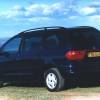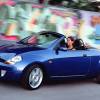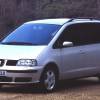
RAC sale – up to 33% off*
• Roadside cover from £5.29 a month†
• We get to most breakdowns in 60 mins or less
• Our patrols fix 4/5 breakdowns on the spot

By Steve Walker
Introduction
People carriers, MPVs, call them what you like, there's a similar concept behind the lot of them. It's to do with providing more practicality and versatility than is usually on offer in a conventional car. When Ford launched its C-MAX, there was some debate over how effectively it actually achieved the MPV goals. Some felt that the five-seater C-MAX didn't do a whole lot more for the family buyer than the Ford Focus hatchback on which it was based. Fortunately, the C-MAX also mimicked the excellent Focus in other ways and following an extensive facelift in 2007, its talents became easier to appreciate.
Models
Models Covered:
5dr compact MPV: 1.6, 1.8, 2.0 petrol, 1.6 TDCI, 1.8 TDCI, 2.0 TDCI diesel [Studio, Style, Zetec, Titanium])
History
The C-MAX was launched in 2003 as the Ford Focus C-MAX but here we're concentrating on the post-facelift cars which arrived early in 2007. By that stage, the Focus part of the name had been dropped and, importantly, Ford's MPV range had been supplemented by the arrival of a new Galaxy and the S-MAX in 2006.
Unlike the larger S-MAX and Galaxy, the C-MAX is a compact MPV that went up against rivals including the Vauxhall Zafira, Citroen's C4 Picasso and Renault's Scenic. When it was launched with five seats and no option for a seven-seater version, the C-MAX looked a little under prepared for a marketplace where the majority of the big players were at least available in seven-seat guise.
With the arrival of the S-MAX in particular, the Ford MPV range looked a lot more balanced and comprehensive. Customers who couldn't fit their lives in a five-seat C-MAX but didn't want a frumpy large MPV had somewhere to go other than a rival manufacturer's showroom. This left the C-MAX free to compete with the five-seater competition, a job it did rather well with its sharp driving experience and tidy looks. Those looks gained a sportier edge when the 2007 facelift was brought in and the C-MAX was finally replaced by an all new model in 2010. Tellingly, the 'new' C-MAX was immediately available in standard form or as a Grand C-MAX with seven seats.
What You Get
Ford didn't need to do too much when facelifting the C-MAX as it was already a very competent product. Endowing it with a little extra personality and desirability was the name of the game with the revamp and the results were good. The styling is a good deal less introverted on these later cars with a redesigned front end that includes elements that appeared on the S-MAX in 2006 and were rolled out across the Ford range. Most notable are the trapezoid lower front grille, a redesigned upper grille, headlights and tail lamps. If the optional bi-xenon lights are specified, a light strip runs across the top line of the lamp unit and all models have LED tail lights.
Ford's rear seat flexibility system remained as the ace in the C-MAX hole. A 40-20-40 "tip and tumble" rear bench sees the centre section flip rearwards into the luggage compartment, leaving the remaining two seats to slide diagonally along a runner towards the centre of the car. This gives prodigious levels of space for four. With 100mm of extra legroom and 60mm of additional shoulder room, even extravagantly dimensioned passengers should be able to find space in the back of the C-MAX. Even in the standard three-abreast bench position, there's plenty of room with 946mm of legroom and 582 litres of luggage compartment space. Remove the rear seats altogether and there's a monstrous 1,692 litres available.
Equipment levels were also increased on this generation C-MAX. Some standard features that are noteworthy include an MP3 connector socket in the centre console, while the Titanium model features blue tinted glass. The range ran from entry level Studio trim through Style, sporty Zetec and the rather techno Titanium. Of the options available, the panorama glass roof was perhaps the most desirable. This covers almost the entire roof area and features internal blinds and a Solar Reflect coating to ensure you don't feel as if you're driving a mobile propagator.
Sports packs were also available for the first time on the 2007 cars. These included an alloy wheel upgrade, sports suspension, racy seats, a three-spoke steering wheel and a body coloured spoiler.
What You Pay
Please fill in the form here for an exact up-to-date information.
What to Look For
All of the engines are tough units and the diesels are especially good, so no major mechanical issues there. The cabins are reasonably hardwearing too but look for damage in the rear caused by tots. The C-MAX tends not to be driven quite as hard as regular Focus models but it's still worth keeping an eye out for mega mileage company hacks. Worn carpets, and scuffed trim are the usual clues.
Check that all the electrical items work properly, ensure that the air conditioner delivers chilled air soon after the engine is started and remember that there's no excuse for missed servicing so look for a detailed history.
Replacement Parts
(approx based on a Focus C-MAX 1.6) As you might expect, parts are plentiful and relatively inexpensive. A clutch assembly will be around £115 and an alternator should be close to £165.
Brake pads are around £35 a front set with rear shoes around £45 and a replacement headlamp is close to £140. A full exhaust is about £275 and a catalyst is about £285. Dampers are around £60 each and a radiator about £140.
On the Road
Six basic engines were offered, the range split neatly between three petrols and three diesels. The 90bhp 1.6-litre TDCi diesel unit is followed by a 115bhp 1.8-litre TDCi unit. Pick of the range however, has to be the punchy 135bhp 2.0-litre TDCi engine. Backed up by a six-speed gearshift, this engine has the pace to get the most from the impressive chassis while maintaining economy befitting of an MPV. All of the diesels were available with an environmentally-friendly Diesel Particulate Filter (DPF) which cut harmful emissions. Petrol buyers are catered for with 100bhp 1.6-litre 16v, 125bhp 1.8-litre and 145bhp 2.0-litre options.
Fuel economy across the board was very good for the time, with the 2.0-litre diesel engine good for 48.7mpg on the combined cycle. Even the petrol engines are relatively frugal, the entry-level 1,.6-litre capable of getting just over 40 miles from a gallon of unleaded but this figure will dip significantly if the car is loaded and the engine extended.
The C-MAX only really had one rival for the crown of best-handling MPV-style vehicle and when Honda pensioned off the Stream in 2005, the Ford stood alone as the driver's choice. There's never been a duff-handling Focus derivative and once you've dropped the kids off at school, the C-MAX is a car that you can enjoy on the twisty route home.
During the development cycle, an all-electric steering set-up was developed that offered far better feedback than any electric power steering system to date. The thing was though, it still wasn't as good as the existing helm, so despite being undoubtedly clever, it was ditched. Instead, Ford uses a hydroelectric pump system that offers great feel and a three per cent fuel saving over the conventional systems fitted to rivals. This, coupled with the celebrated control blade rear suspension, ensures that the C-MAX feels a very capable handler.
Overall
It took the introduction of the bigger and bolder S-MAX to really kick the C-MAX into life but it was worth the wait. Originally launched as a rather bland Focus derivative that hid the light of its talented chassis under a bushel and was questioned for its lack of seven-seat capacity, the C-MAX looked more at home with the 2007 facelift flaunting its sporty side.
The adaptable rear seating system and higher roof do give extra practicality over a normal family hatch, as does the more upright seating position. The C-MAX will best suit those who need this practicality but want an enjoyable driving experience to go with it. There are alternative compact MPVs that go further to meet the needs of the family but none do more for whoever's behind the wheel.





![Ford Focus [MK3] [C346] (2011 - 2014) used car review](https://d1ix0byejyn2u7.cloudfront.net/drive/images/made/drive/images/remote/https_d2yv47kjv2gmpz.cloudfront.net/filestore/1/4/1/1_7492af0a7315231/acbcad938bb70a67379c109f64c22609/1141_af8bd6b17dae840_100_100_70_c1_c_c.jpg)

